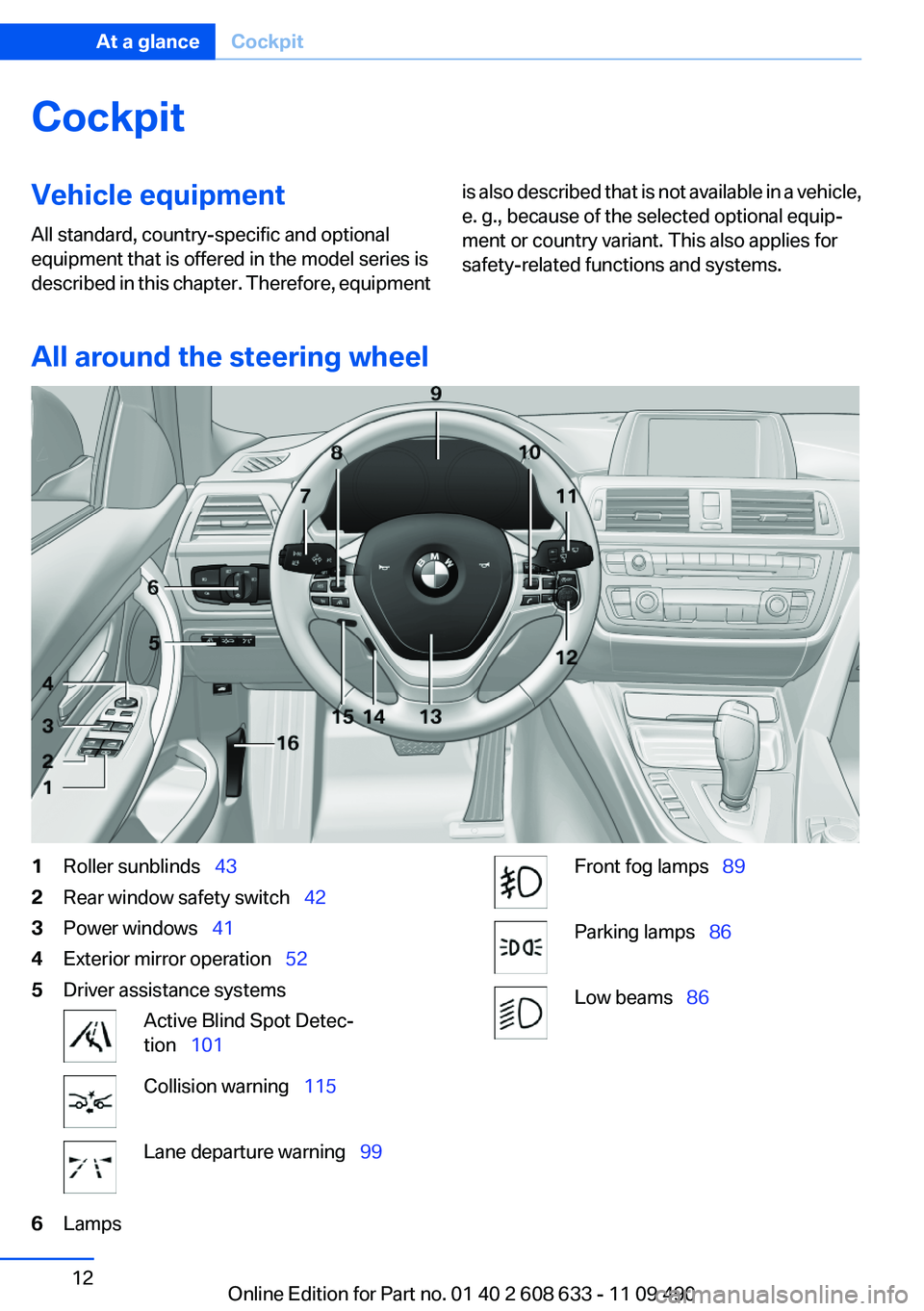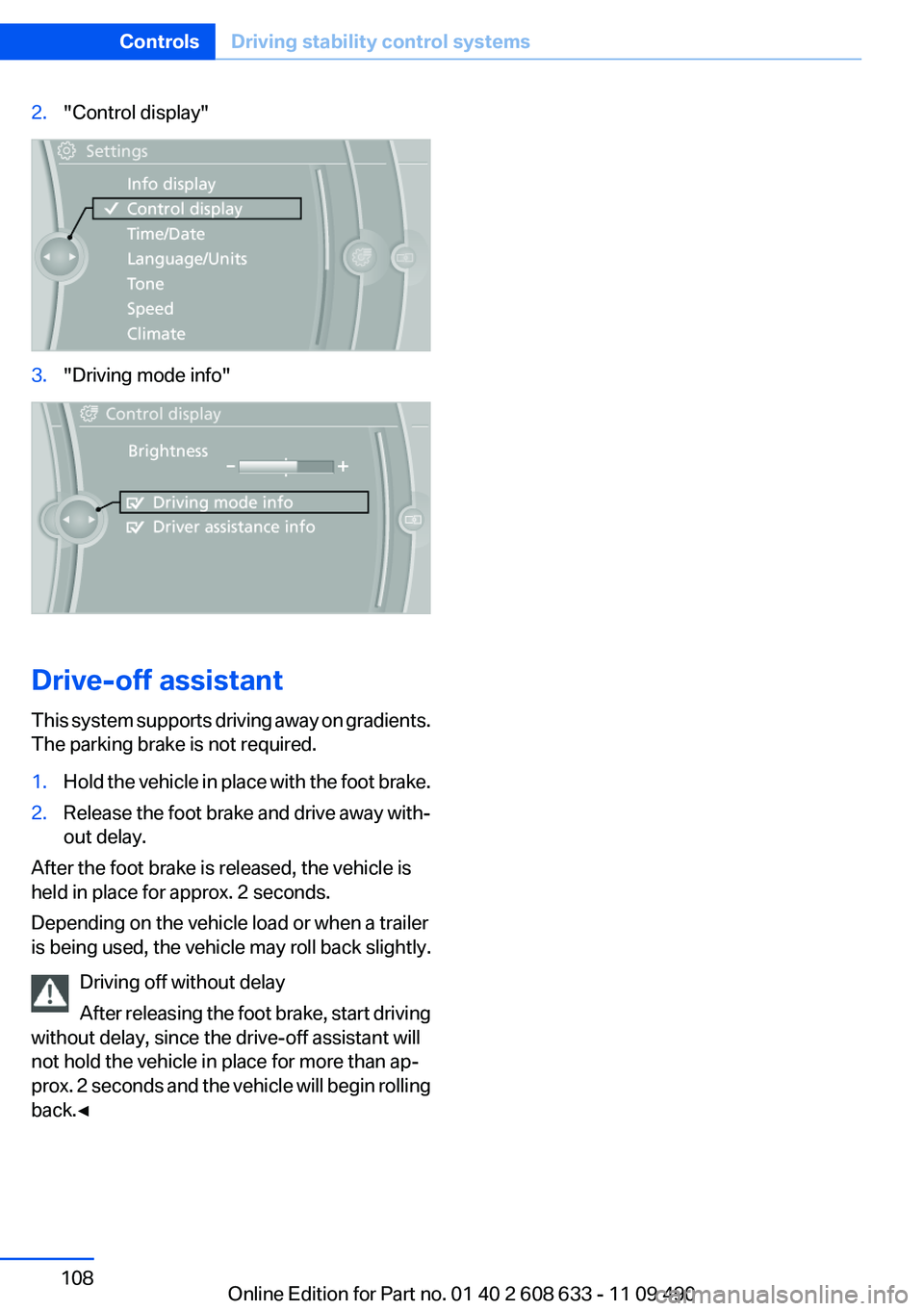2011 BMW 3 SERIES park assist
[x] Cancel search: park assistPage 12 of 325

Cockpit
Vehicle equipment
All standard, country-specific and optional
equipment that is offered in the model series is
described in this chapter. Therefore, equipment
is also described that is not available in a vehicle,
e. g., because of the selected optional equip‐
ment or country variant. This also applies for
safety-related functions and systems.
All around the steering wheel
1Roller sunblinds 43
2Rear window safety switch 42
3Power windows 41
4Exterior mirror operation 52
5Driver assistance systems
Active Blind Spot Detec‐
tion 101
Collision warning 115
Lane departure warning 99
6Lamps
Front fog lamps 89
Parking lamps 86
Low beams 86
Seite 12
At a glanceCockpit
12Online Edition for Part no. 01 40 2 608 633 - 11 09 490
Page 13 of 325

Automatic headlamp con‐
trol 87
Daytime running lights 87
Adaptive light control 88
High-beam Assistant 88
Instrument lighting 89
7Steering column stalk, left
Turn signal 64
High beams, head‐
lamp flasher 64
High-beam Assistant 88
Roadside parking lamps 87
Computer 81
8Steering wheel buttons, left
Store speed 119
Resume speed 120
Cruise control on/off, interrupt‐
ing 119
Active Cruise Control on/off, inter‐
rupting 109
Increase distance 111
Reduce distance 111
9Instrument cluster 70
10Steering wheel buttons, right
Entertainment source
Volume
Voice activation 23
Business mobile phone prepara‐
tion package 220
Professional mobile phone prepa‐
ration package 228
11Steering column stalk, right
Windshield wipers 65
Rain sensor 65
Clean the windshields and head‐
lamps 66
12Start/stop the engine and switch
the ignition on/off 60
Auto Start/Stop function 61
13Horn
14Steering wheel heating 53
15Adjust the steering wheel 53
16Unlock hood 273
Seite 13
CockpitAt a glance
13Online Edition for Part no. 01 40 2 608 633 - 11 09 490
Page 14 of 325

All around the center console
1Headliner 15
2Control Display 16
3Ventilation 139
4Hazard warning system 290
Central locking system 33
5Glove compartment 148
6Radio 190
CD/multimedia 198
7Climate control 134
8Controller with buttons 16
9Parking brake 63
10PDC Park Distance Control 121
Backup camera 123
Parking assistant 130
Surround View 123
11Driving Experience Switch 106
DSC Dynamic Stability Con‐
trol 104
12Transmission selector lever 67 67
Seite 14
At a glanceCockpit
14Online Edition for Part no. 01 40 2 608 633 - 11 09 490
Page 62 of 325

Display in the instrument cluster
The READY display in the tach‐
ometer signals that the Auto
Start/Stop function is ready to
start the engine automatically.
Note
The engine is not switched off automatically in
the following situations:
▷External temperature below approx. +37 ℉/
+3 ℃.
▷The external temperature is high and auto‐
matic climate control is running.
▷The passenger compartment has not yet
been heated or cooled to the required level.
▷The engine is not yet at operating tempera‐
ture.
▷The wheels are at a sharp angle or the steer‐
ing wheel is being turned.
▷After driving in reverse.
▷Fogging of the windows when the automatic
climate control is switched on.
▷The vehicle battery charge is very low.
▷The engine compartment lid is unlocked.
▷The parking assistant is activated.
▷Stop-and-go traffic.
▷The transmission selector lever is in position
N or S/M.
Starting the engine
The engine starts automatically under the fol‐
lowing conditions:
▷Manual transmission:
The clutch pedal is pressed.
▷Automatic transmission:
By releasing the brake pedal.
After the engine starts, accelerate as usual.
Safety mode
After the engine switches off automatically, it
will not start again automatically if any one of the
following conditions are met.
▷The driver's safety belt is unbuckled and the
driver's door is open.
▷The hood was unlocked.
Some indicator lamps light up for varying
lengths of time.
The engine can only be started via the Start/
Stop button.
Note
Even if driving away was not intended, the de‐
activated engine starts up automatically in the
following situations:
▷Excessive warming of the passenger com‐
partment when the cooling function is
switched on.
▷The steering wheel is turned.
▷Automatic transmission: the transmission
position is changed from D to N, R, or M/S.
▷Automatic transmission: the transmission
position is changed from P to N, D, R, or M/
S.
▷The vehicle begins rolling.
▷Fogging of the windows when the automatic
climate control is switched on.
▷The vehicle battery charge is very low.
▷Excessive cooling of the passenger com‐
partment when the heating is switched on.
▷Low brake vacuum pressure; this can occur,
for example, if the brake pedal is depressed
a number of times in succession.
Preventing an automatic engine stop
with automatic transmission
The concept
To make it possible to drive away very quickly,
such as at an intersection, the automatic engine
stop can be actively prevented.
Seite 62
ControlsDriving
62Online Edition for Part no. 01 40 2 608 633 - 11 09 490
Page 74 of 325

Several of the lamps are checked for proper
functioning and light up temporarily when the
engine is started or the ignition is switched on.
Overview: indicator/warning lamps
Symbol Function or system
Turn signal
Front fog lamps
Rear fog lamp
High beams
High-beam Assistant
Parking lamps, headlamp control
Active Cruise Control
Vehicle detection, Active Cruise
Control
Collision warning
Adjustable speed limit
Cruise control
Lane departure warning
Symbol Function or system
DSC Dynamic Stability Control
DSC Dynamic Stability Control is de‐
activated or DTC Dynamic Traction
Control is activated
Tire Pressure Monitor
Flat Tire Monitor
Safety belts
Airbag system
Steering system
Emissions
Parking brake
Brake system
In Canadian models
Parking brake
Brake system
Antilock Brake System ABS
Antilock Brake System ABS in Cana‐
dian models
At least one Check Control message
is displayed or is stored (symbol in
display)
Text messages
Text messages in combination with a symbol in
the instrument cluster explain a Check Control
message and the meaning of the indicator and
warning lamps.
Seite 74
ControlsDisplays
74Online Edition for Part no. 01 40 2 608 633 - 11 09 490
Page 86 of 325

Lamps
Vehicle equipment
All standard, country-specific and optional
equipment that is offered in the model series is
described in this chapter. Therefore, equipment
is also described that is not available in a vehicle,
e. g., because of the selected optional equip‐
ment or country variant. This also applies for
safety-related functions and systems.
At a glance
1Rear fog lamps
2Front fog lamps
3Automatic headlamp control / Adaptive
Light Control / high-beam Assistant / wel‐
come lamps / daytime running lights
4Lamps off / daytime running lights
5Parking lamps / daytime running lights
6Low beams / welcome lamps / High-beam
Assistant
7Headlamp range control
8Instrument lighting
Parking lamps/low beams,
headlamp control
General information
Switch position: 0,
If the driver door is opened with the ignition
switched off, the exterior lighting is automati‐
cally switched off at these switch settings:
Parking lamps
Switch position : the vehicle lamps light
up on all sides, e.g., for parking.
Do not use the parking lamps for extended pe‐
riods; otherwise, the battery may become dis‐
charged and it would then be impossible to start
the engine.
When parking, it is preferable to switch on the
one-sided roadside parking lamps, refer to
page 87.
Low beams
Switch position with the ignition switched
on: the low beams light up.
Welcome lamps
When parking the vehicle, leave the switch in
position or : the parking and interior
lamps light up briefly when the vehicle is un‐
locked.
Activating/deactivating
1."Settings"
2."Lighting"
3."Welcome light"
The setting is stored for the remote control cur‐
rently in use.
Seite 86
ControlsLamps
86Online Edition for Part no. 01 40 2 608 633 - 11 09 490
Page 89 of 325

Switching the high beams on and off
manually
▷High beams on, arrow 1.
▷High beams off/headlamp flasher, arrow 2.
The High-beam Assistant can be switched off
when manually adjusting the light. To reactivate
the High-beam Assistant, press the button on
the turn signal lever.
System limits
Personal responsibility
The high-beam assistant cannot serve as
a substitute for the driver's personal judgment
of when to use the high beams. Therefore, man‐
ually switch off the high beams in situations
where this is required to avoid a safety risk.◀
The system is not fully functional in situations
such as the following, and driver intervention
may be necessary:
▷In very unfavorable weather conditions,
such as fog or heavy precipitation.
▷In detecting poorly-lit road users, such as
pedestrians, cyclists, horseback riders and
wagons; when driving close to train or ship
traffic; and at animal crossings.
▷In tight curves, on hilltops or in depressions,
in cross traffic or half-obscured oncoming
traffic on freeways.
▷In poorly-lit towns and cities and in the pres‐
ence of highly reflective signs.
▷At low speeds.
▷When the windshield in front of the interior
rearview mirror is fogged over, dirty or cov‐
ered with stickers, etc.
Camera
The camera is located near the base of the mir‐
ror.
Keep windshield clean and clear in the area in
front of the interior rear view mirror.
Fog lamps
Front fog lamps
The parking lamps or low beams must be
switched on.
Press the button. The green indicator
lamp lights up.
If the automatic headlamp control, refer to
page 87, is activated, the low beams will come
on automatically when you switch on the front
fog lamps.
Instrument lighting
Adjusting
The parking lamps or low beams
must be switched on to adjust the
brightness.
Adjust the brightness using the
thumbwheel.
Seite 89
LampsControls
89Online Edition for Part no. 01 40 2 608 633 - 11 09 490
Page 108 of 325

2."Control display"
3."Driving mode info"
Drive-off assistant
This system supports driving away on gradients.
The parking brake is not required.
1.Hold the vehicle in place with the foot brake.
2.Release the foot brake and drive away with‐
out delay.
After the foot brake is released, the vehicle is
held in place for approx. 2 seconds.
Depending on the vehicle load or when a trailer
is being used, the vehicle may roll back slightly.
Driving off without delay
After releasing the foot brake, start driving
without delay, since the drive-off assistant will
not hold the vehicle in place for more than ap‐
prox. 2 seconds and the vehicle will begin rolling
back.◀
Seite 108
ControlsDriving stability control systems
108Online Edition for Part no. 01 40 2 608 633 - 11 09 490